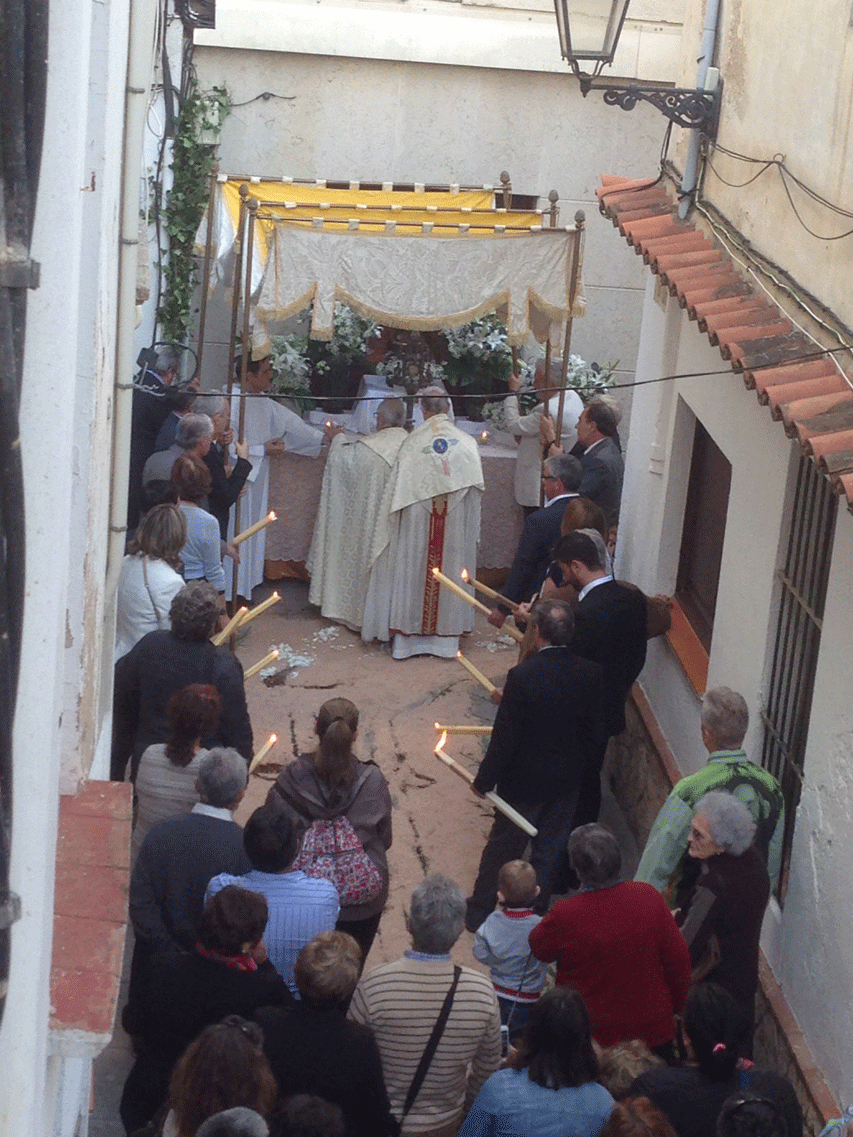June 1, 2016
Corpus Christi

When our neighbors Ana and Tony asked us to join in with the decorations of our street Carrer San Telm during Corpus Christi, we were honored and delighted. This was another stage in our integration into the life of our pueblo, Tossa de Mar. For years, we had been mere spectators of what we understood as described by the locals as the procession of the virgins. I had been caught up in a succession of misunderstandings about the festival, but finally its real meaning finally dawned on me.
At first, I had thought it was a celebration of the Virgin Mary, images that I had seen in photos of similar civic events worldwide. But in this festival, there wasn't the usual iconic statuette of Mary held aloft in procession. When I heard it described many times by the locals as a parade led by preteen children, I chuckled to myself about what seemed to be a narrative of deflowering, a kind of bar mitzvah celebrating the onset of adulthood. In the event, the townsfolk paint the streets with flowers. Then the procession led by a boy and girl, would proceed to deface and erase the painted streets as they walked over it in what seemed to me to be a lurid promise of their eventual loss of virginity. After all, this is the land of the Caganero, a figurine of a child excreting a turd, usually positioned in the rear of a Christmas nativity scene. I think that I am still correct in ascertaining that this is a relic of the pre-Christian religion in this region, a syncretic insertion as a completion of a grand cycle in a world narrative. As of yet, I can not get any confirmation of this from my Catalan friends, only a bemused chuckle and little else that is informative about it.
When Ana told me that the plan for the decoration was to be a pentagrama, alarms sounded in my head. I interpreted this to mean a satanic symbol. Ana and Tony came of age in the Punk era, I thought at first that this was some subversive act of rebellion to have priests walk over a seditious symbol against authority. Catalonia was after all, the home of anarchismo. Maybe this was an aspect of that? Tony amusedly corrected me when he read my face, and said that it was a pentagrama musical, not a pentagrama demonio. What a relief! They intended instead to celebrate one of the town's early 20th century artists, the musician Enric Granados. A pentagramo in Castellano is the graphical armature for musical notation, five lines, five bars (I'm not a musician and I'm typing this without rescue to a web search). The street was to be adorned with the notes of one of Granados' compositions.
It was a long afternoon sitting on our haunches, sifting coffee grounds and what looked like chicken feed, arranging stems of flowers and petals into the pattern of Granados' work. As we watched the procession erase the music, I began to finally understand what was going on. This is what I had learned:
Created in the 13th century in Brussels as a response to concerns about flagging faith, Corpus Christi is an exteriorization of Christian Eucharistic liturgy into the urban streets in which the church is situated. A celebration of the personal sacrifice of G-d to mankind, the symbolic transubstantiation of bread and wine into the body of Christ is the essence of the liturgy. It's worth dwelling on this aspect of personal sacrifice. In the context of the emergence of monotheism in history, the overarching demands of a deity over mankind used to be the norm, sacrifice was what people did to appease the gods. After twenty centuries, it's easy to discount the magnitude of the revolution. With Judaism, the once interminable internecine wars of tribe versus tribe had been symbolically superseded by the global tribe of monotheism which installed G-d as the ultimate tribal chieftain. The Christian turn was a sacrifice by G-d to mankind that flipped the narrative from interminable tribal wars that sought an endless remedy to the injury to dignity -the very definition of humiliation- to an ultimate act of humility by the supreme agency of a one and only Godhead. This succession of humility over humiliation is encoded in Matthew 7:12, the Golden Rule: "do unto others as you would have them do unto you". The world extension of Western Civilization is proof of the isometric property of the Golden Rule. If you believe the rule, you believe in Christ.


Leave a comment